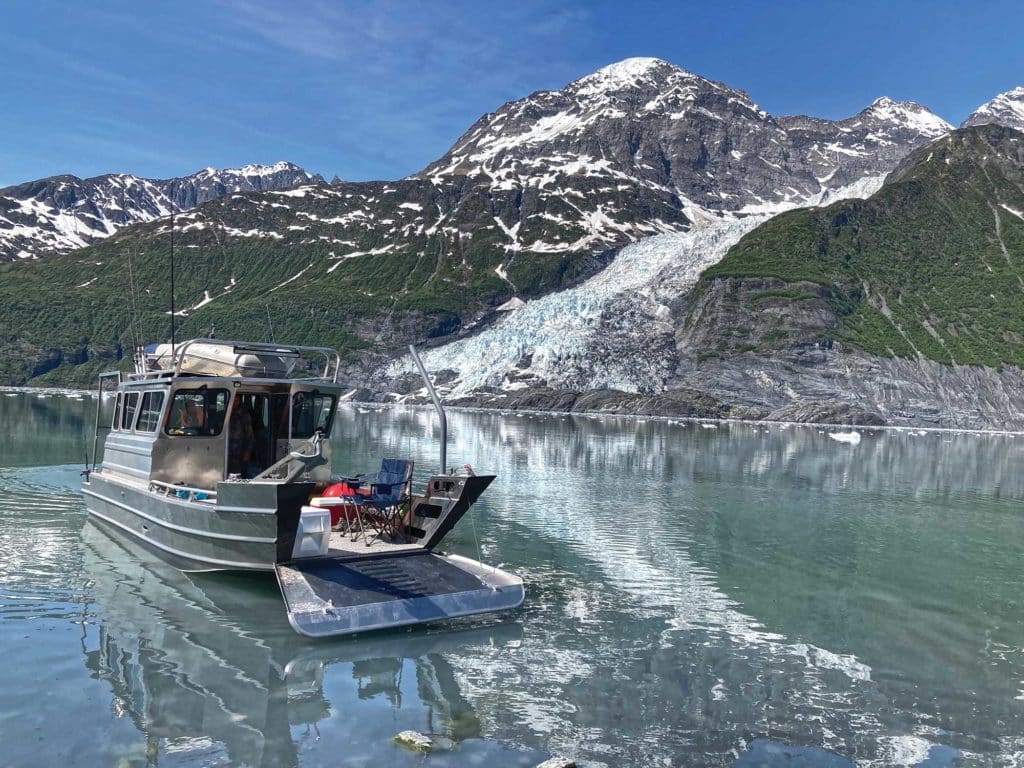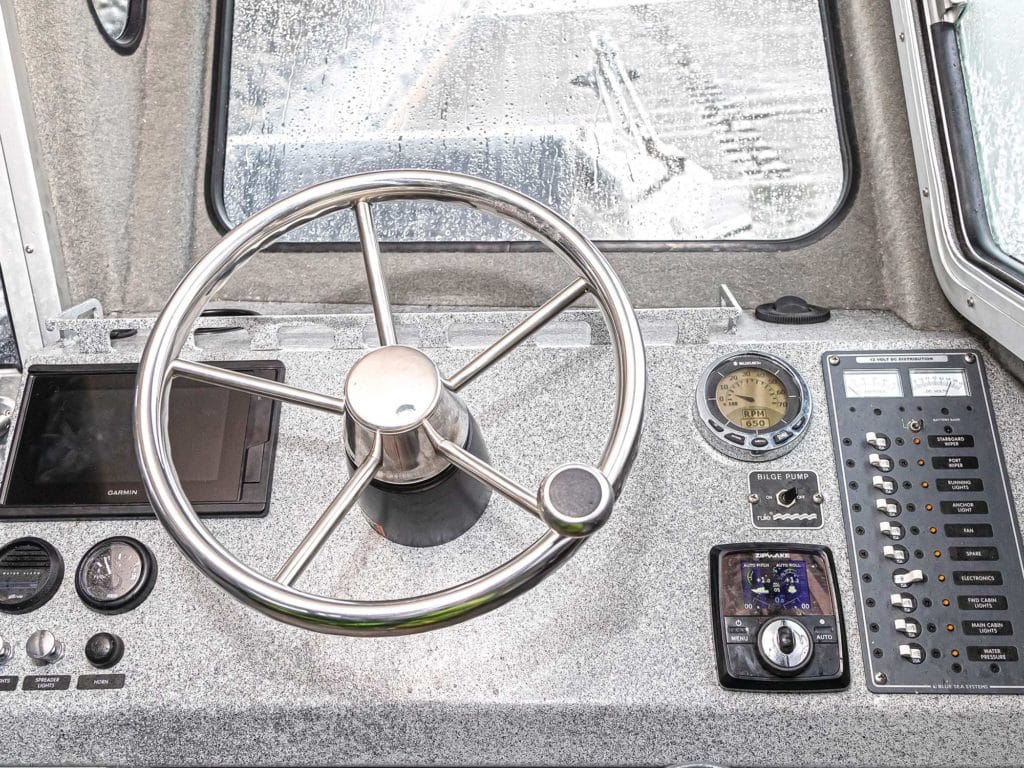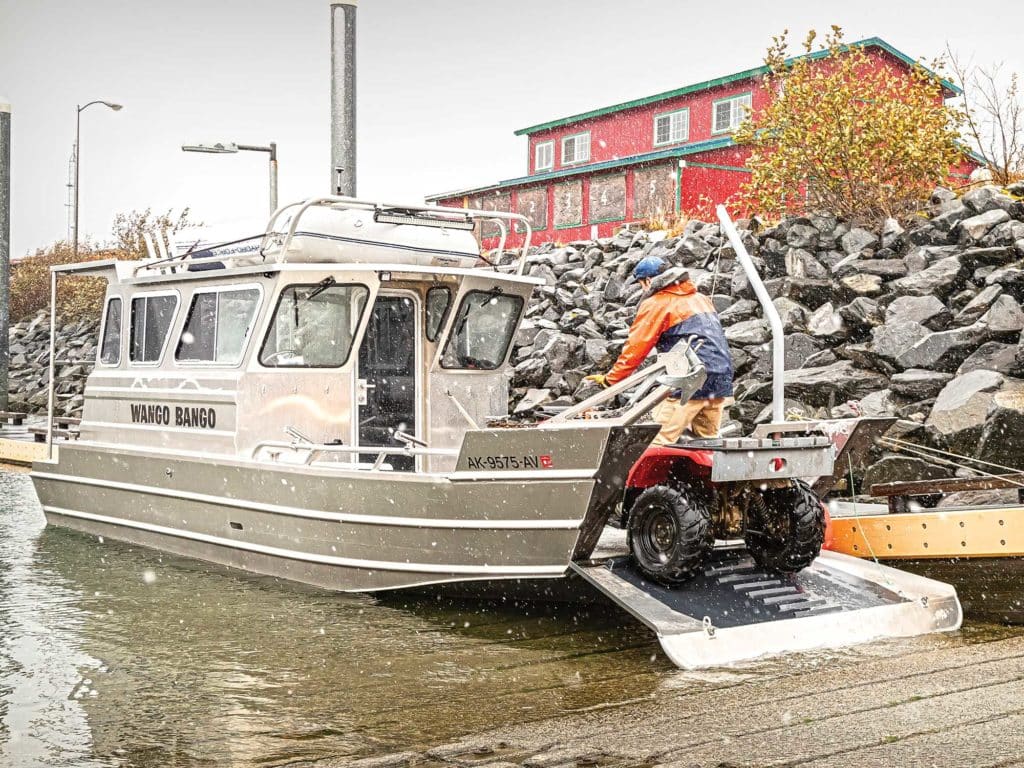
We approached the glacier with caution. The water was littered with growlers—floating chunks of blue-white ice, some the size of a 150-quart cooler. We steered around the largest and heard smaller pieces of ice bump the boat and then scrape harmlessly alongside the hull as we made way at idle speed. The air temperature grew cooler, and the water became milky in the outflow of the glacier, which, still a mile away, already appeared indescribably massive.
Our guide pointed out dozens of harbor seals sunning on growlers, perfectly comfortable and sound asleep with their backs on the ice. To port loomed a much bigger piece of ice, perhaps the size of an F-150 pickup truck. Maybe inspired by the seals, a crazy notion popped into my head. Here was my chance, perhaps the only opportunity in my lifetime, to stand on an iceberg. Many people fly to Alaska and see eagles soaring, catch a 100-pound halibut, or even spot a brown bear loping across the tundra. But how many are lucky enough—or dumb enough—to stand on top of an iceberg?

When I asked Capt. Tom Werth if he would maneuver me over to the ’berg, he just laughed and turned the wheel to begin our approach. In any other boat, climbing down onto the iceberg would be a tricky deal. But we were aboard Wango Bango, Werth’s custom aluminum adventure boat, which features a landing-craft-style bow ramp. When we got about 10 feet away from the iceberg, Werth lowered the ramp and edged close enough that I could simply step off the boat and onto the ice, then strike a gallant photo pose while my family shook their collective heads.
Werth did not order this boat with a bow ramp so he could deposit his Uncle Charles onto an iceberg. But when you have a rugged, welded-aluminum boat with a ramp, no adventure seems out of reach.

Born to Adventure
My sister’s oldest son, Werth is an Alaska native who grew up on the Kenai Peninsula and has long been attracted to the water. The family always had boats, one set up for fishing Cook Inlet, and another with a flat bottom for hunting trips down the Yukon River. While still in high school, Werth started working as a hand on a fishing charter boat out of Seward. He earned an OUPV (six-pack) captain’s license, and then captained a fishing charter out of Ninilchik for four summers, spent two more fishing out of Seward, and another as captain of a water taxi in Whittier. In between, he earned an engineering degree at Montana State University and started training to become a backcountry guide. A couple of years ago, he moved back to Alaska to do the “real job” thing with a gas utility in Anchorage, and continues to chase adventure mountain biking and backcountry skiing in the Chugach Range, often in the company of his adventurous fiancée, Molly Swartz. The first leg of these ski trips is made by snow machine from Turnagain Pass, but more backcountry could be accessible if an approach were made from the eastern Prince William Sound side of the range. This would require putting the snow machine on a boat—a boat with a ramp on the bow. If the boat could tote a snow machine, it could also put an ATV ashore during deer-hunting season, or a crew of friends ashore for a weekend camping trip. With the notion of turning Prince William Sound into his year-round playground, Werth started imaging the perfect multimission boat for that water.

The Fabricator
The man building just such a boat, Delbert Henry, is curiously far away from the ocean in Palmer, Alaska, northeast of Anchorage in the Matanuska-Susitna Valley. A Montana native, Henry founded Hylite Fabrication in 2009 as a welding specialty outfit; in 2011, he engaged in a joint venture to build Peregrine Falcon Alaska, a 90-by-24-foot aluminum landing-craft-style research boat. This high-profile project established Hylite’s fine reputation, and more boatbuilding work came its way. Henry has built a number of 35-foot bow-pickers and also commercial boats with landing-craft bow ramps. New customers liked the look of these boats and commissioned pleasure versions. He’s finished 10 to date, ranging in length from about 34 to 42 feet.
During his time on the Alaskan waterfront, Werth studied a wide variety of boats, cataloging features he might incorporate into a craft of his own one day. A co-worker introduced him to Hylite in 2019. Henry wanted to build a smaller, more affordable version of his landing-craft pleasure models—the last well-equipped 34-foot example cost about $275,000—and proposed to Werth a 27-foot-length-overall build (24-foot hull length) that he could retail for about $160,000.
“This is a real Prince William Sound boat,” Henry says. “It’s designed to be rugged and stable, with an enclosed house and the ramp on the bow. The water there can get choppy, but big waves or swells are unlikely, so we can build it with shallow deadrise for minimal draft. In many places, he can nose this boat right up to shore and drop the ramp on dry land.”

The boat has 12 degrees of transom deadrise and 6-inch reverse chines for enhanced stability. Fuel capacity is 200 gallons, and the boat’s weight distribution is shifted aft so that it will rest on the desired waterline with a heavy load in the open bow. A set of Zipwake 300S interceptor-type trim tabs can bring the bow down if the load is light. The forward deck is 11 feet, 6 inches long and 8 feet, 6 inches wide. The house is 7 feet, 6 inches long by 8 feet, 2 inches wide, with 6 feet, 2 inches of headroom. The helm is to starboard, with a counter and cabinets abaft. To port is a bench seat with a pivoting backrest and a dinette that converts to a berth. Bulky gear is stowed through a deck hatch to the bilge. The entire house is surrounded by windows, making it very bright. The West Coast windshield affords excellent forward visibility and quickly sheds water. The interior is finished with durable speckled Zolatone paint and powder-coated gray.

At the stern is a back porch about 5 feet, 6 inches deep covered by the extended house roof and fitted with a table with a folding top. With a portable stove on the table, this is the galley. A ladder to port provides access to the house roof, which is surrounded by a low rail, rod holders, tie-downs for an inflatable dinghy, and a low radar arch.
The ramp raises and lowers with cables connected to a -hand-crank winch. An extended anchor roller is welded to the starboard gunwale. Decking throughout is aluminum diamond plate. Werth chose not to spec a head or a formal galley to save space and expenses, and keep the boat simple to maintain. When guests are along, everyone usually camps on shore.

Wango Bango is built like a workboat. The bottom is ¼-inch-thick-plate 5086 alloy. Hullsides are 3/16-inch stock, and the house is 1/8 inch. The transom is solid ½-inch aluminum and can accommodate single or twin outboards. Cross members and stringers are aluminum extrusions. Henry normally builds this type of boat with a forward crash bulkhead and sealed forward compartments; if a sharp impact ruptures the hull, the boat will remain afloat. Werth had a hatch placed in the center of the forward deck, so it’s sealed well but not airtight. Turns out, he’s never used that compartment for stowage and now would prefer a fish box in the deck. The foredeck drains overboard through side scuppers.
In the Hylite shop, this boat’s project name was 401K because Werth’s retirement fund paid for much of it. At 31, he has plenty of time to start over. But his budget was tight. To that end, the boat is powered by a 2007 Suzuki DF250 outboard, which provides adequate power and was reliable during the boat’s first season in 2021. Werth stores the boat on a $6,500 custom Hi-Tech Marine trailer shipped up from Panama City, Florida.

A Glacial Place
A day on the water aboard Wango Bango was the highlight of our family trip to Alaska last summer. Werth and Swartz picked us up at the Whittier dock, and we motored out of the inlet and headed north into the open water of Port Wells. Our first stop was the marker for shrimp pots that Werth and Swartz had dropped the night before. Werth deployed a portable electric winch to the port gunwale to pull up the pots, which were 600 feet down. The pots were filled with shrimp as big as my hand. Next, we navigated into Barry Arm, where we began to encounter the growlers, a raft of dozens of sea otters, and the sleeping seals. Werth approached to within a half-mile of Coxe Glacier and killed the engine.
“We’ll watch for a bit and see if anything happens,” he said.
We could hear the glacier occasionally crack and groan, and suddenly kaboom! The glacier calved right before our eyes, a huge piece falling into the water just like on NatGeo. We’d only waited for five minutes.

“Right on time,” Werth said. What a great guide. He put us ashore to explore around the rubble at the base of the receding glacier, and we could scramble right to the edge of the ice. A Coleman stove on the aft table boiled up the fresh shrimp for lunch, after which we picked our way back through the growlers, into Port Wells and the waypoint Werth had marked the day before when a pair of 85-pound halibut were hauled aboard Wango Bango. Our luck, unfortunately, was not as good.
I was allowed to take the wheel on the run back to Whittier. The ride was stiff into a crisp afternoon chop, the compromise for shallow draft and stability. But the boat runs true on course and is plenty agile. Back at Whittier, our adventure was over. But it seems clear for Werth and Swartz, who will be married this summer, that the adventure is just beginning.
Read Next: Trailer Boating in Alaska

All About Prince William Sound
The northernmost reach of the Gulf of Alaska, Prince William Sound is surrounded by steep snowcapped mountains of the Chugach National Forest and deep fjords still holding blue glacial ice. The land around the sound is mostly wilderness, save for the fishing village of Cordova to the east, the oil port of Valdez to the north, and the historic port town of Whittier to the west. The area has survived the 1964 Good Friday earthquake and resulting tsunami, and the 1989 Exxon Valdez oil spill, which fouled the water and shoreline with crude and devastated wildlife. Whittier, a popular put-in point for boaters from Anchorage, is accessible by a one-lane toll road through a railroad tunnel.









